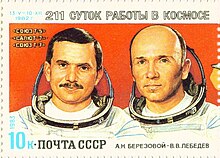
Back Союз Т-5 Bulgarian Soiuz T-5 Catalan Sojuz T-5 Czech Sojus T-5 German Soyuz T-5 Spanish سایوز تی۵ Persian Sojuz T-5 Finnish Soyouz T-5 French Soiuz T-5 Galician סויוז T-5 HE
| COSPAR ID | 1982-042A |
|---|---|
| SATCAT no. | 13173 |
| Mission duration | 106 days, 5 hours, 6 minutes, 11 seconds |
| Spacecraft properties | |
| Spacecraft type | Soyuz-T |
| Manufacturer | NPO Energia |
| Launch mass | 6,850 kilograms (15,100 lb) |
| Crew | |
| Crew size | 2 up 3 down |
| Launching | Anatoli Berezovoy Valentin Lebedev |
| Landing | Leonid Popov Aleksandr Serebrov Svetlana Savitskaya |
| Callsign | Эльбру́с (Elbrus) |
| Start of mission | |
| Launch date | May 13, 1982, 09:58:05 UTC |
| Rocket | Soyuz-U |
| Launch site | Baikonur 1/5 |
| End of mission | |
| Landing date | August 27, 1982, 15:04:16 UTC |
| Landing site | 225 kilometres (140 mi) E of Dzhezkazgan |
| Orbital parameters | |
| Reference system | Geocentric |
| Regime | Low Earth |
| Perigee altitude | 190 kilometres (120 mi) |
| Apogee altitude | 231 kilometres (144 mi) |
| Inclination | 51.6 degrees |
| Period | 89.7 minutes |
| Docking with Salyut 7 | |
 Elbrus crew Soyuz programme (Crewed missions) | |
Soyuz T-5 was a human spaceflight into Earth orbit[2] to the then new Salyut 7 space station in 1982.[1] While the Soyuz-T was docked it received visits from the uncrewed Progress 13 resupply spacecraft, and the crewed Soyuz T-6 and Soyuz T-7.[1]
The first crew hand launched an amateur radio satellite, the T-6 mission included a visiting Frenchman, and T-7 included the first woman in space in 20 years.[1] It was the first mission to Salyut 7, but more than one spacecraft could be docked to S7 at a time, which is why the later missions could overlap with Soyuz T-5.[1] The spacecraft launched with two people ("Elbrus crew"), and returned with three ("Dnieper crew").[1]
- ^ a b c d e f David Portree - Mir Hardware Heritage (1995) - Page 90-95 - NASA RP1357 Archived 2009-09-07 at the Wayback Machine
- ^ The mission report is available here: http://www.spacefacts.de/mission/english/soyuz-T-5.htm